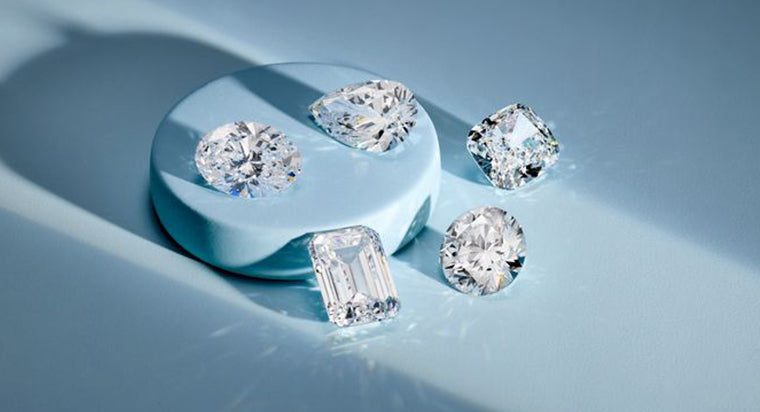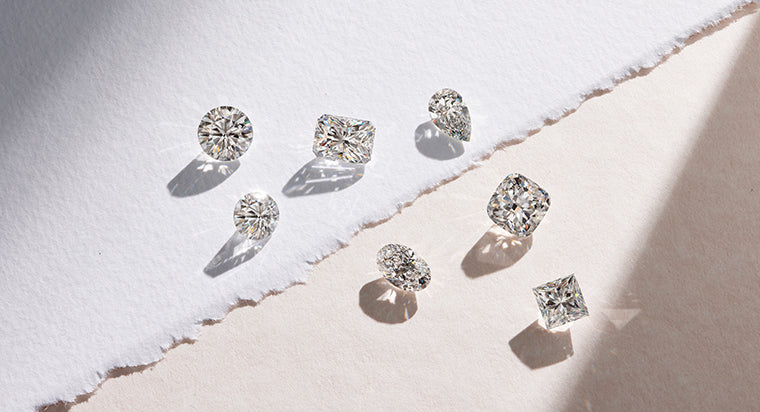Your Ultimate Guide to Understanding Diamond Carat and Size

Carat is one of the most important of the four C's of diamond buying: It's the globally recognized standard for the weight of a diamond (not to be confused with karat, a measure of gold purity). Although we’re sure you’ll have many brides-to-be argue that it’s the most important of the aspects since it has such a big impact on the look of your engagement ring. You'll hear a lot about it while you're shopping for your engagement ring, so here are the most important things to know, including how much a carat weighs and how it's priced. To get a quick understanding on Diamond Carat, watch our co-founder Anubh discuss this topic below.
TABLE OF CONTENTS
How much does a diamond carat weigh?
A 1 carat (or ct) diamond weighs 0.20 grams. Contrary to popular belief, the carat is not the size of the diamond. A diamond's size is measured in millimeters, length by width — in other words, the diameter of the diamond. It typically takes about 250 tons of rock mining to produce a single 1 carat diamond. That's why diamonds are rare and expensive.
Diamonds come in a variety of shapes and carat weights. A diamond cutter’s highest priority is to maximize carat weight. The larger the diamond, the rarer and therefore more expensive it is. Diamonds are weighed very precisely, to the nearest 0.01ct.
Before universal adoption of the carat in 1907, a variety of measurements were used for diamonds. (At one point carob seeds were used, because it was believed incorrectly that the mass of each seed didn't vary much.) Over time, carat weight became standardized. It's now a common point of reference on the certificate of any diamond, regardless of which institution certifies it.
Diamond carat size comparison
Although each diamond is unique, it is possible to approximate visual size, especially because modern diamonds are cut with machines to ensure precision. Within each carat range, diamonds have an average size in millimeters.
Well-cut round diamonds have less depth than well-cut fancy-shaped diamonds (diamonds other than round). A 1ct round diamond will have ~6.40mm length/width, while a 1ct Princess diamond, which will measure ~5.50mm.
Fancy shapes tend to have more weight and less size. So round-cut diamonds will cost more than fancy shapes of the same carat weight.
Visually, it's hard to tell the difference between diamonds that vary 5 to 10 percent in carat weight. For example, a 0.95ct and 1ct diamond will be nearly indistinguishable. (Take note if you want a 1ct diamond but don’t want to pay the price for that popular round weight!)
If a diamond is cut too deep, it may look smaller than a lower-carat diamond. When looking at carat weight and millimeter size, it is also important to consider length-to-width ratios for each diamond shape. These will help you understand if a diamond is too shallow or too deep, or if it has desirable proportions. A deep-cut 1ct diamond might look smaller than a 0.95ct shallow-cut diamond.
Remember: A carat is a weight, so a diamond's measurement in millimeters can vary depending on how it's cut. Choose diamonds that are cut very well. Those diamonds tend to have less depth and more spread. This means their measurements are larger, making the diamond look visually larger than its carat weight.
Diamond MM Chart

Carat price effect: What does a diamond carat cost?
Diamond pricing increases exponentially — not linearly — as diamond carat weight increases. That means once a diamond hits it’s critical weight, the price bumps up. The critical weights are 0.30ct, 0.40ct, 0.50ct, 0.70ct, 0.90ct 1.00ct, 1.50ct, 2.00ct, 3.00ct, 4.00ct, 5.00ct and 10.00ct.
Diamond cutters will do everything they can to keep the diamond weight at or above each critical weight. Diamond manufacturers and suppliers also know this trick, so they’ll price their diamonds accordingly. It might be smart to buy a 0.95ct diamond instead of 1 carat, but the former option is difficult to find. (Luckily, here at With Clarity, you have our team of expert gemologists to help you track down just the right stone in the right carat size.)
CARAT PRICE FOR LAB GROWN DIAMONDS
When purchasing within the same budget, try looking at lab diamond comparisons. Lab grown diamonds have the same physical, chemical, and optical properties as a natural diamond. The only stark difference is where they were created (earth vs laboratory). Refer to our table below to see price comparisons of round natural and lab diamonds. View certified lab diamond catalog.
Diamond Carat and Price
NATURAL DIAMONDS VS LAB DIAMONDS (BASED OFF ROUND SHAPES).
| Carat Size | 0.25 | 0.50 | 0.75 | 1.00 | 1.25 | 1.50 | 2.00 | 2.50 | 3.00 | 3.50 | 4.00 | 4.50 | 5.00 |
|---|---|---|---|---|---|---|---|---|---|---|---|---|---|
| Natural Diamond Price | $480 | $2,360 | $3,030 | $10,010 | $8,210 | $13,470 | $23,850 | $33,200 | $75,360 | $62,660 | $102,790 | $117,130 | $151,770 |
| Lab Diamond Price | $120 | $510 | $1,100 | $1,550 | $2,360 | $3,080 | $5,800 | $7,105 | $10,660 | $15,720 | $24,940 | $31,650 | $36,630 |
Values are estimated and can vary based on our inventory.
YOU NEED TO UNDERSTAND "MAGIC SIZES"
You can save quite a bit of money on your engagement ring if you're wary of "magic sizes"— the numbers that cost more just because they're in demand, or a critical weight. Although there's no visual difference between a 1.99ct diamond and a 2.00ct, the 2ct can cost far more because it's a magic size. Diamonds that aren’t these “magic sizes” are called “off-size diamonds,” and they just might be the key to getting the engagement ring of your dreams.
What is the average diamond carat weight?
The average diamond carat weight is 0.90ct.
Try to buy a diamond below the critical weight, a.k.a. the point at which diamond prices increase substantially. For example, 0.95ct vs. 1ct. The price will increase exponentially as 1ct is a critical weight.
How important should carat be when buying a diamond?
Carat tends to be the most visual and popular of the 4 C's. Therefore some people will want to consider carat weight first. (We would say you should probably make your first priority diamond cut, but it all depends on your preferences.) But carat weight isn't the only thing that matters — it must be balanced.

When pricing diamonds, think about carat on one side, and the remaining 3 C’s — cut, color, clarity — on the other side. To stay within your budget, as you increase carat you may need to de-emphasize the other C’s. Conversely, if you increase the other C’s, you may need to choose a lower carat. A larger carat size will fill up more of the hand, but if you don't maximize for cut and clarity, that bigger diamond will have less sparkle.
See our diamond price estimator to understand the approximate pricing across a variety of diamond sizes, combined with the other diamond attributes.
Diamond carat sizes on hand
Below, you can see how different diamond carat sizes look on a hand. When shopping, consider her hand size as well as her finger size. Keep in mind that most fancy diamond shapes like emerald, oval and pear will look larger on the hand than a round diamond of the same carat weight. Learn more about the various diamond shapes to understand which is the best fit for her ring.) And consider that once set within a ring, the diamond carat weight can look even larger, depending on ring style.
Below are round diamonds that measure 0.25ct, 0.50ct, 0.75ct, 1.00ct, 2.00ct, 3.00ct, 4.00ct and 5.00ct respectively.











